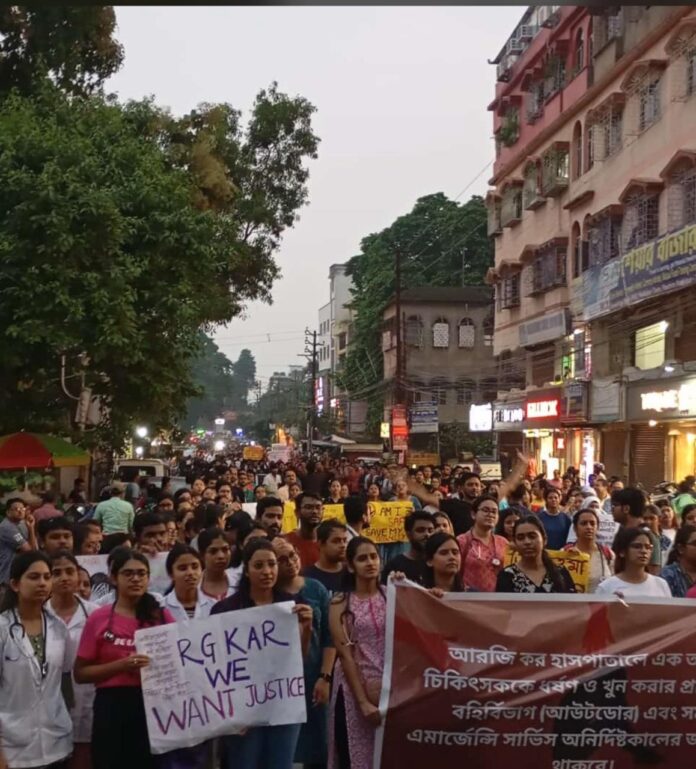Utsa Sarmin, TwoCircles.net
Kolkata: The brutal rape and murder of a 31-year-old postgraduate trainee doctor at Kolkata’s state-run R.G. Kar Hospital has sparked widespread outrage and protests in the city. However, the case has also been marred by a wave of misinformation, particularly surrounding the post-mortem report.
Initial reports and social media speculation claimed that a substantial amount of semen, ranging from 150 grams to 150 milligrams, was found on the victim’s body. There were also claims that, considering the amount of semen found, two or three people were involved in the crime. However, a detailed post-mortem report accessed by News18 has clarified these claims.
The report explains that the 150-gram figure, which fueled much of the initial public outcry, actually refers to the weight of the victim’s uterus — a standard measurement in such examinations. Additionally, the forensic team, which reached the crime scene almost five hours after the incident, noted the absence of any significant fluid quantity due to its congealed state, complicating the forensic analysis.
Furthermore, a forensic report accessed by the local Bengali newspaper Anandabazar Patrika contradicts earlier social media speculations claiming that the body had multiple bone fractures. While the report does not mention any broken bones, it details injuries to the head, cheeks, lips, nose, right jaw, chin, neck, left hand, left shoulder, left knee, ankle and genitals. The report also states that the doctor had a blood clot (hemorrhage) in their lungs.
A postgraduate trainee doctor who participated in the protests expressed concern about the spread of misinformation. Not wishing to be names, she stated, “It is regrettable that the police did not take steps to curb speculation about the forensic report. Everyone is drawing their own conclusions.”
She also mentioned, “I don’t even understand how the forensic report was shared with the media. Forensic reports are confidential; it is evidence, part of the investigation. Ideally, no one except the victim’s family and the investigative authorities should have access to the reports.”
Her sentiments were echoed by a senior police official at Lalbazar, who confirmed that the media’s understanding of the case is limited. He said, “The media is surely reporting about the findings. But I can say that even journalists do not know what had actually transpired. Only the CBI knows, and they will present the report in court.”
The Central Bureau of Investigation (CBI) is currently leading the investigation.
Being part of a team that accessed the crime scene, the official mentioned that one cannot ascertain that the crime occurred where the victim’s body was found. The original scene of the crime could well be the bathroom or any other room in the hospital.
On August 9, the body of the young doctor was found in the hospital’s seminar hall.
Rajdeep Shaw, a second-year postgraduate trainee doctor at the All India Institute of Hygiene and Public Health with previous experience as house staff at R.G. Kar Medical College, revealed that the bathroom, a sleeping room used by patients during the day and interns at night, and the seminar hall were in close proximity. Any of these spaces could be the original crime scene.
Shaw further criticised the hospital’s response, stating that no measures were taken to secure the crime scene after the body was discovered. “People were freely entering and exiting, compromising the evidence,” he said.
A forensic investigation was not initiated until seven hours later, during which time unrestricted access to the scene continued. Shaw emphasised that these lapses severely compromised the post-mortem examination.
For the police official, the sensationalisation of the forensic report could have acted as a potential hindrance to the investigation “if the case had not been taken up by the CBI. After all, such social media speculations and emotions could result in undue political pressures on the police”.
The post-mortem was conducted by a panel of three doctors, including two female forensic science experts. The report accessed by News18 mentions that to accurately determine the number of perpetrators involved in the crime, investigators are now relying heavily on DNA profiling. Samples collected from the crime scene have been sent to the Central Forensic Science Laboratory (CFSL) for analysis. The results of this DNA testing are crucial and will be shared with the CBI.
According to local media reports, over the weekend, the investigative agency started conducting psychological tests on Sanjay Roy, the main suspect in the rape and murder case. A team of psychology experts from the Central CFSL is handling the questioning of Roy.
The CBI also interrogated Sandip Ghosh, the former principal of R.G. Kar Medical College and Hospital, from August 16 to August 18.


